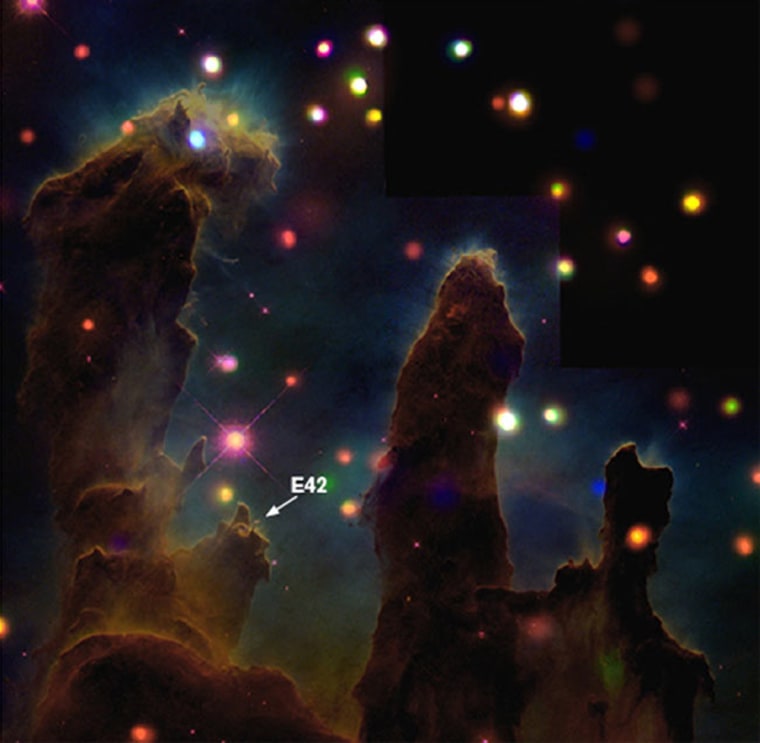Likened to a stellar womb, the iconic soaring space towers known as the Pillars of Creation have revealed an embryo of an infant star that could develop into a twin of our Sun.
Astronomers imaged the baby star in what they consider the earliest stages of development ever detected for this type of object.
Hiding out on a nodule that juts out from the left pillar, “E42” is known as an evaporating gas globule, also referred to as an EGG. An EGG is a dense pocket of interstellar gas that forms an “egg” from which a star emerges. This particular EGG has the same mass as the sun and appears to be maturing in a violent environment matching the one thought to have produced Earth’s life-giving star.
“We think this is a very, very early version of our own sun,” said Jeffrey Linsky of JILA, a joint institute of the University of Colorado, Boulder and the National Institute of Standards and Technology.
Star factory
Linsky and his colleagues used NASA’s Chandra X-ray Observatory to peek at the embryo inhabiting the Eagle Nebula.
Located about 7,000 light-years from Earth, the Eagle Nebula is a star-forming region within the Pillars of Creation where nearby gas and dust feed the birth of new stars. Many of the stars churned out here now reside just outside the pillars, where their ultraviolet emissions sculpt out the structures.
The newbie is one of 73 EGGs discovered in this celestial castle in 1995 with the Hubble Space Telescope. While 11 of the gas globules are thought to contain infant stellar objects, only four are massive enough to form a star. Of those, E42 is the only one that boasts a sun-sized mass.
“The four proto-stars that we have identified on the edges of the pillars are probably the youngest stars ever imaged by astronomers,” Linsky said.
While the X-ray capability let the team view about 1,100 hot, mature stars in the nebula, the EGGs were not emitting any X-rays due to their infantile natures.
Instead the scientists viewed visual and infrared emissions to pinpoint E42 and its neighbors.
“The results indicate young, evolving stars like E42 have not yet developed the magnetic structures needed to produce X-rays,” he said.
Brutal birth
Slideshow 12 photos
Month in Space: January 2014
In addition to its mass, E42 is maturing in an environment similar to what astronomers think produced Earth’s sun, 5 billion years ago. Unlike a nurturing womb, however, Earth’s sun seemed to form from clouds of dust and gas that got seared by ultraviolet radiation and pummeled with shock waves from at least one supernova explosion.
“The sun was likely born in a region like the Pillars of Creation because the chemical abundances in the solar system indicate that a supernova occurred nearby and contributed its heavy elements to the gas of which the Sun and the planets formed,” Linsky said.
In January 2007, a French astronomy team observed a glowing cloud of scorched dust next to the pillars, suggesting that about 6,000 years ago a supernova explosion toppled the stellar structures. The newly described proto-star E42 apparently emerged unscathed.
“My guess is that the shock wave from the supernova may have been far enough away so that E42 and some of the other stars may have survived,” said Linsky. “But I guess we will have to wait another thousand years or so to get the answer.”
The study is published in the Jan. 1 issue of the Astrophysical Journal.

